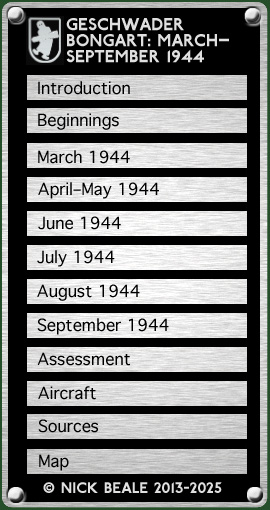|
At 08.30 hrs. Luftflotte 3’s Operations Officer ordered Geschwader Bongart to transfer to Clermont-Ferrand and/or Lyon immediately and to report when this was carried out. At noon, the Geschwader signalled from Bourges that no supply transport had yet arrived at Saint-Yan (where Stab III. and the 7. and 8. Staffeln had been ordered to transfer, see above) and no deliveries could be expected in the next few days. All the available aircraft fuel was being used up by the Ju 88s landing there and it was asked whether a II. Gruppe (unspecified) had been allocated an alternative airfield. The IV. Gruppe was hamstrung too, reporting at 08.30 that owing to the destruction of its landing area it had been unable to fly on the 15th or 16th but there was a “restricted possibility” of operations today. Which airfield this refers to is not known but the bombing of Lyon-Bron and Dijon on the 14th may be relevant. Hauptmann Herbert Phillipp, Operations Officer of the III. Gruppe was injured when his W. 34 came to grief in Luxeuil. Presumably he was inspecting the airfield as a possible future base (see above). Ussel was briefly liberated by the Resistance but the approach of Brigade Jesser led them to withdraw from the town. It was probably while supporting these actions that a Ju 88 C-6 of the 11. Staffel (W.Nr. 360135) crashed 1 km north east of the town’s railway station. Its three crew were posted missing: Fw. Albert Ronneburg (pilot), Uffz. Erich Utikal (wireless operator) and Stabsfw. Karl Kreß (flight mechanic). Toward evening, a message was dropped by Geschwader Bongart to one of Jesser’s units, the I. Bataillon/Sicherungs Regiment (mot.) 1000, asking them to look for a force-landed Junkers near the station. With one of their number wounded, the search party returned at 22.15 (GMT+2), reporting that they had found the aircraft shot to pieces but no sign of its crew.
From 15.40–16.16 hrs., six of JGr. 200's Bf 109s operated against guerillas around Vallon Pont d’Arc, in the high country about 44 km north east of Orange. This and the previous day’s operation by II./JG 77 at nearby Saint-Remèze may have been aimed at keeping open a route east into the Rhône Valley at Pierrelatte (shortly to become one axis for the withdrawal of German forces west of the river). 18 August Late in the day, Luftflotte 3’s Operations Officer issued the following message, reflecting the German collapse in northern France and its consequences for any attempt to defend the south: 1) The development of the situation in the Army Group B area suggests that the 19th Army may possibly be cut off in the near future. OKW has ordered: Army Group G will disengage from the enemy and will join up with the Southern Flank of Army Group B on the line Sens – Dijon – Swiss Frontier. Elements of LXII. Army [actually LXII. Reserve Korps] will withdraw to the French-Italian Alps position … 2) In this connection the following is ordered: … All flying units and ground services, except those mentioned under 2) A) are to be transferred back with the greatest speed by command authorities into the area of Luftflotte 3 behind the line Seine – Sens – Dijon – Swiss frontier. Attention is drawn to the need for complete destruction of ground organisation and all GAF installations left behind to the west of this line. Geschwader Bongart will remain for the time being on its present base aerodromes to fight guerillas. Transfer orders will be sent separately. The Luftwaffe intervened again in the fighting at Égletons and at 1625 local time, callsign »Kabeljau« (codfish) signalled to Genltn. Otto Ottenbacher, “Urgent: own airmen bombing us”, this incident reportedly causing the worst German casualties of the battle. Jesser’s Brigade noted that “Kampfgeschwader Bongart” was supporting the fighting of the Kampfgruppe led by Oberst Georg Coqui.
German troops had reached their besieged countrymen at 11.30 (GMT+2), finding that the Résistants had withdrawn at first light, on news of their approach. At its command post in the town’s Hôtel de Bordeaux, the I. Bataillon of Sich. Regt. (mot.) 1000 recorded that at 16.00: Égletons is struck by two bombs from an aircraft of unknown nationality [and] Sicherungs Regiment 194 has four dead. Some time later another bombardment takes place, by terrorist flyers making their first appearance. As the II./Sich. Regt. 1000 (mot.) described it: The battalion reached Égletons toward evening … Prior to [our] entry, the town was bombed by about 30 enemy aircraft. The column remained unseen in the woods. One of the bombers is reported to have been shot down by French SAS men. According to their leader, Cap. Claude Wauthier, it was downed “by one of our [Bren] guns, manned by [Guy] Chansel … killing the two pilots. The plane went on to crash some kilometres further on.”. Nevertheless, Brigade Jesser arrived that morning to lift the siege.
In Nyons, Albin Vilhet noted that aircraft (whose nationality he did not state) had bombed the roads, hitting a car, killing one civilian and wounding two more. In addition, a lone aircraft was reported to have bombed Brive-la-Gaillarde. In Bournoncle-Saint-Pierre (Haute-Loire) a German aircraft circled overhead while 22 Resistance fighters were buried following a miscarried attack on a lorry column near Bard two days earlier. The press in Switzerland reported that Germany had formally accepted responsibility for the bombing of Morgins and would pay for the restoration of the buildings damaged in the attack. Allied bombing damaged a Do 17 and destroyed one W.34, a Do 17, an Fi 156 and a Bü 131. continued on next page …
|
|||||

